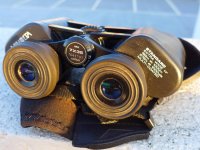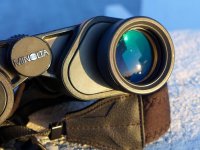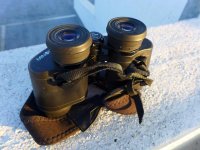I was looking for a wide field binocular a couple months ago and this came up:
7x35
11 degree field of view
Multi-coated
Minolta have a decent reputation for their camera lenses so I picked it up to see what it would be like in the flesh. Some observations after using it several times:
The view:
- My main reason for this purchase was the very wide stated field of view. I found this binocular can in fact be used with glasses, but (as expected) doing so cuts down the field of view quite considerably. I mainly used them without (as I do with my 8x30 Oberkochen and most other porros), rubber eyecups folded down to let my eyes as close to the oculars as possible. Unfortunately for me, this binocular when used without glasses would not focus past infinity enough to get the left barrel as sharp as I would like at the distances I was observing over (240 to about 700m), although the right barrel could be got sharp with the diopter adjustment. NB. I have had the same issue with two Opticron porros (HRWP and SRGA) and much to my regret, the Nikon EII.
- At the closer of my observing distances (240m) the image was just sharp enough to observe but at this distance appeared to suffer from noticeable distortion, enough that I'd often feel I was struggling against the optics. I have to note, though, that this seemed to be an issue only at the extreme end of focus as I tried it at shorter distances of between 3 (indoors) and about 40-50m and did not experience the same difficulty. At those distances the image could be got nice and sharp and the sweet spot seemed larger/edge sharpness seemed better than it did at distance. Brightness was noticeably superior to the single-coated 8x30 Oberkochen and (from memory) a little superior to the multi-coated 8x30W Jenoptem I used to own. The Oberkochen I felt offered more contrast.
- Field of view itself was certainly pretty wide and along with the 5mm exit pupil made it very easy to capture the flocks of pigeons I wanted to see. Recently, however, I was able to test it alongside a 7x42BGAT*P Dialyt and, putting both binoculars on landmarks, found the Minolta's actual field of view to be pretty much the same as the Dialyt's. I haven't tried to measure apparent or true field of view more exactly but strongly suspect the stated field of view is shall we say optimistic. That, of course, is by no means unknown and a field of view of some 150m or so at 1000m is still pretty respectable... but not what I was looking for. If the field of view had been as stated I'd have kept it and sent it for adjustment (sacrificing close focus for more focus past infinity) but that not being the case was the major reason for my moving it on last week.
Handling:
- I found the Minolta a pleasant enough binocular to use, with my hands taking readily to the rounded edges and thumbs resting quite naturally under the bridge bars. It's not a small binocular, but not really large either and if it really could offer an 11 degree field of view it would have achieved it in a compact package compared to things like the wide angle Swifts. Weight (measured on my kitchen scale) was 880g.
- Focus wheel position was fine, the focuser itself having a bit of resistance to it but I prefer focus resistance to be on the stiff side. No problems here.
- The overall impression of build quality was positive - not massively refined, but solid. Diopter tension could be stiffer. The rubber armouring looks and feels fit for purpose, although I don't think I would risk it in any precipitation heavier than a light drizzle.
All in all I found this to be a decent binocular - not outstanding, but better than "chum for a plastic-chewing shark" (to quote WJC). Field of view is wide, although not as wide as stated, and image quality at distances below about 200m or so is again not outstanding but perfectly adequate. It feels quite solidly built and for those not as myopic as me, should give a combination of decent view and solid build at a very reasonable price.
7x35
11 degree field of view
Multi-coated
Minolta have a decent reputation for their camera lenses so I picked it up to see what it would be like in the flesh. Some observations after using it several times:
The view:
- My main reason for this purchase was the very wide stated field of view. I found this binocular can in fact be used with glasses, but (as expected) doing so cuts down the field of view quite considerably. I mainly used them without (as I do with my 8x30 Oberkochen and most other porros), rubber eyecups folded down to let my eyes as close to the oculars as possible. Unfortunately for me, this binocular when used without glasses would not focus past infinity enough to get the left barrel as sharp as I would like at the distances I was observing over (240 to about 700m), although the right barrel could be got sharp with the diopter adjustment. NB. I have had the same issue with two Opticron porros (HRWP and SRGA) and much to my regret, the Nikon EII.
- At the closer of my observing distances (240m) the image was just sharp enough to observe but at this distance appeared to suffer from noticeable distortion, enough that I'd often feel I was struggling against the optics. I have to note, though, that this seemed to be an issue only at the extreme end of focus as I tried it at shorter distances of between 3 (indoors) and about 40-50m and did not experience the same difficulty. At those distances the image could be got nice and sharp and the sweet spot seemed larger/edge sharpness seemed better than it did at distance. Brightness was noticeably superior to the single-coated 8x30 Oberkochen and (from memory) a little superior to the multi-coated 8x30W Jenoptem I used to own. The Oberkochen I felt offered more contrast.
- Field of view itself was certainly pretty wide and along with the 5mm exit pupil made it very easy to capture the flocks of pigeons I wanted to see. Recently, however, I was able to test it alongside a 7x42BGAT*P Dialyt and, putting both binoculars on landmarks, found the Minolta's actual field of view to be pretty much the same as the Dialyt's. I haven't tried to measure apparent or true field of view more exactly but strongly suspect the stated field of view is shall we say optimistic. That, of course, is by no means unknown and a field of view of some 150m or so at 1000m is still pretty respectable... but not what I was looking for. If the field of view had been as stated I'd have kept it and sent it for adjustment (sacrificing close focus for more focus past infinity) but that not being the case was the major reason for my moving it on last week.
Handling:
- I found the Minolta a pleasant enough binocular to use, with my hands taking readily to the rounded edges and thumbs resting quite naturally under the bridge bars. It's not a small binocular, but not really large either and if it really could offer an 11 degree field of view it would have achieved it in a compact package compared to things like the wide angle Swifts. Weight (measured on my kitchen scale) was 880g.
- Focus wheel position was fine, the focuser itself having a bit of resistance to it but I prefer focus resistance to be on the stiff side. No problems here.
- The overall impression of build quality was positive - not massively refined, but solid. Diopter tension could be stiffer. The rubber armouring looks and feels fit for purpose, although I don't think I would risk it in any precipitation heavier than a light drizzle.
All in all I found this to be a decent binocular - not outstanding, but better than "chum for a plastic-chewing shark" (to quote WJC). Field of view is wide, although not as wide as stated, and image quality at distances below about 200m or so is again not outstanding but perfectly adequate. It feels quite solidly built and for those not as myopic as me, should give a combination of decent view and solid build at a very reasonable price.
Attachments
Last edited:







